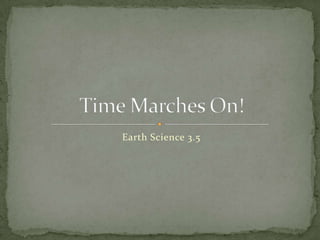
Earth Science 3.5 : Time Marches On
- 1. Earth Science 3.5 Time Marches On!
- 2. Explainhow geologic time is recorded in rock layers. Identify important dates on the geologic time scale. Explain how changes in climate resulted in the extinction of some species. Objectives:
- 3. Geologic Time The Rock Record and Geologic Time Grand Canyon National Park is one of the best places in North America to see Earth’s history recorded in rock layers. These rock layers represent almost half, or nearly 2 billion years, of Earth’s history. The Fossil Record and Geologic Time Fossils of plants and animals are common in sedimentary rocks that belong to the Green River formation. These fossils are well preserved. Burial in the fine-grained lake-bed sediments preserved even the most delicate structures.
- 4. The Geologic Time Scale The geologic column represents the 4.6 billion years that have passed since the first rocks formed on the Earth. To aid in their study, geologists have created the geologic time scale. The geologic time scale Standard method used to divide the Earth’s long natural history into manageable parts. Divisions of Time Geologists have divided the Earth’s history into sections of time. An eon Largest division of geologic time. The four eons are the Hadean eon, theArchean eon, theProterozoic eon, and the Phanerozoic eon.
- 5. Eons are divided into eras. For example, the Phanerozoic Eon is divided into three eras. Periods Third-largest divisions of geologic time and are the units into which eras are divided. Periods are divided into epochs. The fourth-largest division of geologic time. The Appearance and Disappearance of Species At certain times during Earth’s history, the number of species has increased or decreased dramatically. Result of a relatively sudden increase or decrease in competition among species.
- 7. The number of species decreases dramatically over a relatively short period of time during a mass extinction event. Extinctionis the death of every member of a species. Events such as global climate change can cause mass extinctions.
- 8. The Paleozoic Era — Old Life Lasted from about 542 million to 251 million years ago. First era that is well represented by fossils. Marine life flourished at the beginning of the era and the oceans became home to a diversity of life. However, there were few land organisms. By the middle of the Paleozoic era, Most modern groups of land plants had appeared. By the end of the Paleozoic era, Amphibians and reptiles lived on the land, and insects were abundant. The era came to an end with the largest mass extinction in Earth’s history. Some scientists believe that changes in seawater circulation were a likely cause of this extinction, which killed nearly 90% of all marine species.
- 9. The Mesozoic Era — The Age of Reptiles Began about 251 million years ago. During this era, reptiles, such as dinosaurs, dominated the land. Small mammals appeared about the same time as dinosaurs, and birds evolved late in the era. At the end of the Mesozoic era, About 15% to 20% of all species on Earth, including the dinosaurs, became extinct. Global climate change may have been the cause.
- 10. The Cenozoic Era — The Age of Mammals The Cenozoic era began about 65.5 million years ago and continues to the present. This era is known as the “Age of Mammals.” After the mass extinction at the end of the Mesozoic era, mammals flourished. Mammals were able to survive the environmental changes that probably caused the extinction of the dinosaurs.